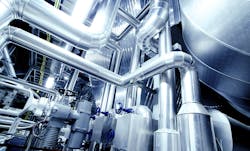Manufacturers instruct users to install straight run upstream and downstream of their flowmeters. Is straight run necessary? Not really.
Many flowmeters are affected by the velocity profile upstream and/or downstream of the flowmeter. Other flowmeters are not affected at all.
The velocity profile describes the velocities and swirls that are present in a cross-section of a pipe. A good velocity profile generally consists of a non-swirling uniform fluid flow with symmetric point velocities in the cross-section. A typical velocity profile exhibits lower velocities near the pipe wall and higher velocities near the center of the pipe. Failure to develop a good velocity profile upstream and/or downstream of many flowmeters can affect their measurements and thereby adversely affect their performance.
Re-stated succinctly, many flowmeters can be affected by a distorted velocity profile. There a number of techniques that can be used to develop a good velocity profile. The most common approach is to install straight run upstream and downstream of the flowmeter where the fluid can sufficiently attenuate velocity profile distortion that may be present. Flowmeter manufacturers typically publish the amounts of straight run necessary for each of their flowmeters to measure accurately.
READ ALSO: QUIZ CORNER—What’s the Purpose of Straight Run Pipe in Flowmeter Installations?
However, there are other approaches that can be used to develop a good velocity profile. One such approach is to install a flow conditioner upstream of the flowmeter where a sufficiently good velocity profile is developed a short distance downstream of the flow conditioner. Flow conditioners are often applied when insufficient space is available to install the straight run specified by the manufacturer and/or when large amounts of velocity profile distortion are present. Different flow conditioner designs are used to reduce different types of velocity profile distortion. For example, some flow conditioners are more suitable to reduce swirl whereas other designs tend to reduce profile distortion.
Therefore, straight run is not strictly necessary if another technique is used to develop a sufficiently good velocity profile so as to not adversely affect flowmeter performance.
David W. Spitzer
David W. Spitzer is a regular contributor to Flow Control magazine and a principal in Spitzer and Boyes, LLC offering engineering, seminars, strategic, marketing consulting, distribution consulting and expert witness services for manufacturing and automation companies. Spitzer and Boyes is also the publisher of the Industrial Automation INSIDER. Mr. Spitzer has more than 40 years of experience and has written over 10 books and 300 articles about flow measurement, instrumentation and process control. He can be reached at 845 623-1830 or via spitzerandboyes.com. Click on the "Products" tab to find his Consumer Guides to various flow and level measurement technologies.



